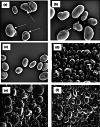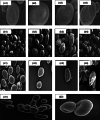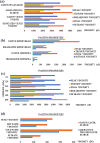Alternative food processing techniques and their effects on physico- chemical and functional properties of pulse starch: a review
- PMID: 37711574
- PMCID: PMC10497490
- DOI: 10.1007/s13197-022-05557-3
Alternative food processing techniques and their effects on physico- chemical and functional properties of pulse starch: a review
Abstract
Thermal processing remains the key processing technology for food products. However, there are some limitations for thermal processing such as loss of sensory and nutritional quality. Furthermore, nowadays consumers are looking forward for fresh like products which are free from chemical preservatives, yet having longer shelf life. Thus, alternative processing techniques are gaining popularity among food processors to replace conventional thermal processing keeping nutritional quality, sensory attributes and food safety in mind. The alternative processing techniques such as ultrasound, gamma irradiation, high pressure processing and microwave treatment causes several modifications (structural changes, effects on swelling and solubility index, gelatinization behaviour, pasting or rheological properties, retrogradation and cooking time) in physicochemical and functional properties of pulse starches which offers several advantages from commercial point of view. This review aims to summarize the effect of different alternative processing techniques on the structure, solubility, gelatinization, retrogradation and pasting properties of various pulse starches.
Supplementary information: The online version contains supplementary material available at 10.1007/s13197-022-05557-3.
Keywords: Gamma irradiation; High pressure processing; Microwave processing; Pulse starch; Ultrasound processing.
© Association of Food Scientists & Technologists (India) 2022. Springer Nature or its licensor holds exclusive rights to this article under a publishing agreement with the author(s) or other rightsholder(s); author self-archiving of the accepted manuscript version of this article is solely governed by the terms of such publishing agreement and applicable law.
Conflict of interest statement
Conflict of interestNo conflicts of interest/Competing interests are associated with this publication.
Figures






Similar articles
-
Starch-based noodles: Current technologies, properties, and challenges.J Texture Stud. 2023 Feb;54(1):21-53. doi: 10.1111/jtxs.12730. Epub 2022 Nov 2. J Texture Stud. 2023. PMID: 36268569 Review.
-
Mechanisms of the different effects of sucrose, glucose, fructose, and a glucose-fructose mixture on wheat starch gelatinization, pasting, and retrogradation.J Food Sci. 2023 Jan;88(1):293-314. doi: 10.1111/1750-3841.16414. Epub 2022 Dec 13. J Food Sci. 2023. PMID: 36511442 Free PMC article.
-
Physicochemical, structural, and rheological characteristics of corn starch after thermal-ultrasound processing.Food Sci Technol Int. 2023 Mar;29(2):168-180. doi: 10.1177/10820132211069242. Epub 2021 Dec 23. Food Sci Technol Int. 2023. PMID: 34939430
-
Impact of microwave irradiation on chemically modified talipot starches: A characterization study on heterogeneous dual modifications.Int J Biol Macromol. 2022 Jun 1;209(Pt B):1943-1955. doi: 10.1016/j.ijbiomac.2022.04.172. Epub 2022 Apr 30. Int J Biol Macromol. 2022. PMID: 35500776
-
Effect of dynamic high-pressure treatments on the multi-level structure of starch macromolecule and their techno-functional properties: A review.Int J Biol Macromol. 2024 May;268(Pt 1):131830. doi: 10.1016/j.ijbiomac.2024.131830. Epub 2024 Apr 23. Int J Biol Macromol. 2024. PMID: 38663698 Review.
Cited by
-
Advancements in Pulse Starches: Exploring Non-Thermal Modification Methods.Foods. 2024 Aug 8;13(16):2493. doi: 10.3390/foods13162493. Foods. 2024. PMID: 39200420 Free PMC article. Review.
References
-
- Abdel-Aal ESM, Ragaee S, Rabalski I, Warkentin T, Vandenberg A. Nutrient content and viscosity of Saskatchewan-grown pulses in relation to their cooking quality. Can J Plant Sci. 2019;99(1):67–77. doi: 10.1139/CJPS-2018-0140/ASSET/IMAGES/CJPS-2018-0140TAB5.GIF. - DOI
-
- Acevedo BA, Villanueva M, Chaves MG, Avanza M, v., & Ronda, F. Modification of structural and physicochemical properties of cowpea (Vigna unguiculata) starch by hydrothermal and ultrasound treatments. Food Hydrocoll. 2022;124:107266. doi: 10.1016/J.FOODHYD.2021.107266. - DOI
-
- Aidoo R, Oduro IN, Agbenorhevi JK, Ellis WO, Pepra-Ameyaw NB (2022) Physicochemical and pasting properties of flour and starch from two new cassava accessions 25(1):561–569. Doi: 10.1080/10942912.2022.2052087
-
- Amagliani L, O’Regan J, Kelly AL, O’Mahony JA. Chemistry, structure, functionality and applications of rice starch. J Cereal Sci. 2016;70:291–300. doi: 10.1016/J.JCS.2016.06.014. - DOI
Publication types
LinkOut - more resources
Full Text Sources
